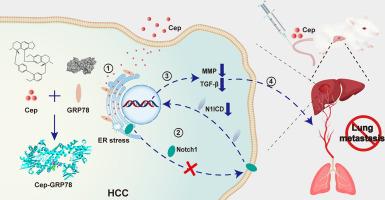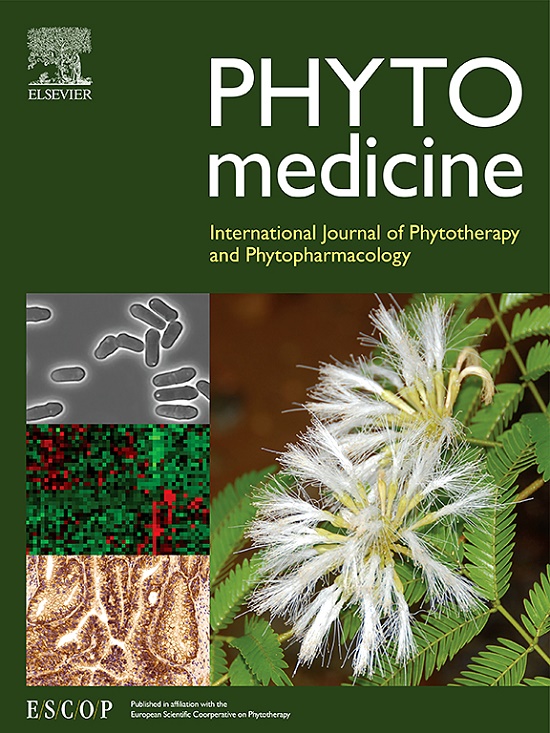环黄嘌呤介导的内质网应激通过结合GRP78抑制Notch1,从而抑制肝细胞癌转移
IF 8.3
1区 医学
Q1 CHEMISTRY, MEDICINAL
引用次数: 0
摘要
背景:肝细胞癌(HCC)的转移会导致不良预后,而Notch1的激活是其中一个重要因素。Cepharanthine(Cep)因其有效的抗病毒功能和多变的细胞内靶点而被发现。我们之前的研究仅报道了 Cep 在肺癌中的抗癌功效,并未进行深入探讨。本研究旨在探讨 Cep 在 HCC 中的抗转移作用、涉及的靶点及其分子机制:方法:与 C5WBF344 细胞相比,Notch1-N1ICD 稳定过表达产生了 C5WN1 细胞。应用 C5WN1 细胞和携带 C5WN1 细胞的小鼠作为 HCC 模型。通过生物信息学分析、RNA测序、分子对接、细胞热转移试验(CETSA)、药物亲和力反应靶点稳定性(DARTS)、微尺度热泳(MST)和瞬时基因敲除等技术来确定潜在靶点。通过细胞凋亡检测、免疫荧光染色、qRT-PCR、Western印迹、Elisa、流式细胞术、迁移和划痕实验、透射电子显微镜(TEM)、激光扫描共聚焦显微镜(LSCM)、显微计算机断层扫描(micro-CT)和组织病理学实验,检测了Notch1的抗HCC疗效、功能和机制:结果:Notch1在HCC中的表达增加,并导致转移。令人惊讶的是,Cep(体外 2 μg/ml,体内 5 mg kg-1)在 C5WN1 细胞和原位小鼠模型中具有强效的 Notch1 信号通路抑制作用和抗转移功效,表现为 Notch1/MMP-2/MMP-9 表达减少、TGF-β 释放减少、细胞迁移减少、肺转移减少和存活期延长。RNA 测序显示,Cep 处理的 HCC 细胞的差异基因位于内质网(ER)。分子对接、CETSA、DARTS 和 MST 进一步确定了 Cep 的可能靶点是分布在 ER 中的 GRP78。不出所料,Cep(2 μg/ml)上调了ER应激的关键分子,如GRP78,诱导了β-淀粉样蛋白的积累,并促进了HCC的钙离子猝灭。相反,抑制 GRP78 可减轻 Cep 诱导的 ER 应激。此外,抑制ER应激可减轻Cep诱导的Notch1失活和HCC细胞迁移:综上所述,本研究发现 Cep 对 HCC 具有良好的抗转移作用,其中 GRP78 可被 Cep 直接结合并激活,导致 ER 应激和 Notch1 受阻。本研究首次揭示了Cep介导的抗癌作用、关键靶点和机制,为植物药的分子靶向治疗提供了新的见解。本文章由计算机程序翻译,如有差异,请以英文原文为准。

Cepharanthine-mediated endoplasmic reticulum stress inhibits Notch1 via binding GRP78 for suppressing hepatocellular carcinoma metastasis
Background
The metastasis of hepatocellular carcinoma (HCC) leads to a poor prognosis, wherein the activation of Notch1 is an essential contributor. Cepharanthine (Cep) has been identified for its effective antiviral function and versatile intracellular targets. Our previous study has only reported the anti-cancer efficacy of Cep in lung cancer, without an in-depth exploration. Herein, the present study aims to investigate the anti-metastasis effect in HCC, the target involved, and the molecular mechanism of Cep.
Methods
Stable over-expression of Notch1-N1ICD yielded C5WN1 cells compared with C5WBF344 cells. The C5WN1 cells and C5WN1 cell-bearing mice were applied as the HCC model. The bioinformatics analysis, RNA sequencing, molecular docking, cellular thermal shift assay (CETSA), drug affinity responsive target stability (DARTS), microscale thermophoresis (MST), and transient knockdown techniques were carried out to identify the underlying target. The apoptosis assay, immunofluorescent staining, qRT-PCR, Western blots, Elisa, flow cytometry, migration and scratching experiments, Transmission electron microscopy (TEM), laser scanning confocal microscopy (LSCM), micro-computed tomography (micro-CT), and histopathological experiments were conducted to assay the anti-HCC efficacy, functions, and mechanism.
Results
Notch1 had an increased expression in HCC and contributed to metastasis thereupon. Surprisingly, Cep (2 μg/ml in vitro, 5 mg kg-1 in vivo) presented potent Notch1 signaling pathway inhibitory effect and anti-metastasis efficacy in C5WN1 cells and in situ mice models as evidenced by reduced Notch1/MMP-2/MMP-9 expression, TGF-β release, decreased cell migration, diminished pulmonary metastases, and prolonged survival. RNA sequencing showed that the differential gene of Cep-treated HCC cells was positioned in the endoplasmic reticulum (ER). Molecular docking, CETSA, DARTS, and MST further identified that the possible target of Cep was GRP78, which was distributed in the ER. As expected, Cep (2 μg/ml) up-regulated the critical molecules of ER stress such as GRP78, induced β-amyloid accumulation, and promoted calcium burst in HCC. In contrast, suppression of GRP78 attenuated Cep-induced ER stress. Furthermore, inhibition of ER stress abated Cep-induced Notch1 inactivation and HCC cells’ migration.
Conclusions
Taken together, the present study finds that Cep possesses excellent anti-metastasis of HCC, wherein the GRP78 could be directly bound and activated by Cep, leading to ER stress and Notch1 blockage. This study reveals for the first time the effect, critical target, and mechanism of the Cep-mediated anti-cancer effect, providing novel insights into the molecular target therapy by phytomedicine.
求助全文
通过发布文献求助,成功后即可免费获取论文全文。
去求助
来源期刊

Phytomedicine
医学-药学
CiteScore
10.30
自引率
5.10%
发文量
670
审稿时长
91 days
期刊介绍:
Phytomedicine is a therapy-oriented journal that publishes innovative studies on the efficacy, safety, quality, and mechanisms of action of specified plant extracts, phytopharmaceuticals, and their isolated constituents. This includes clinical, pharmacological, pharmacokinetic, and toxicological studies of herbal medicinal products, preparations, and purified compounds with defined and consistent quality, ensuring reproducible pharmacological activity. Founded in 1994, Phytomedicine aims to focus and stimulate research in this field and establish internationally accepted scientific standards for pharmacological studies, proof of clinical efficacy, and safety of phytomedicines.
 求助内容:
求助内容: 应助结果提醒方式:
应助结果提醒方式:


